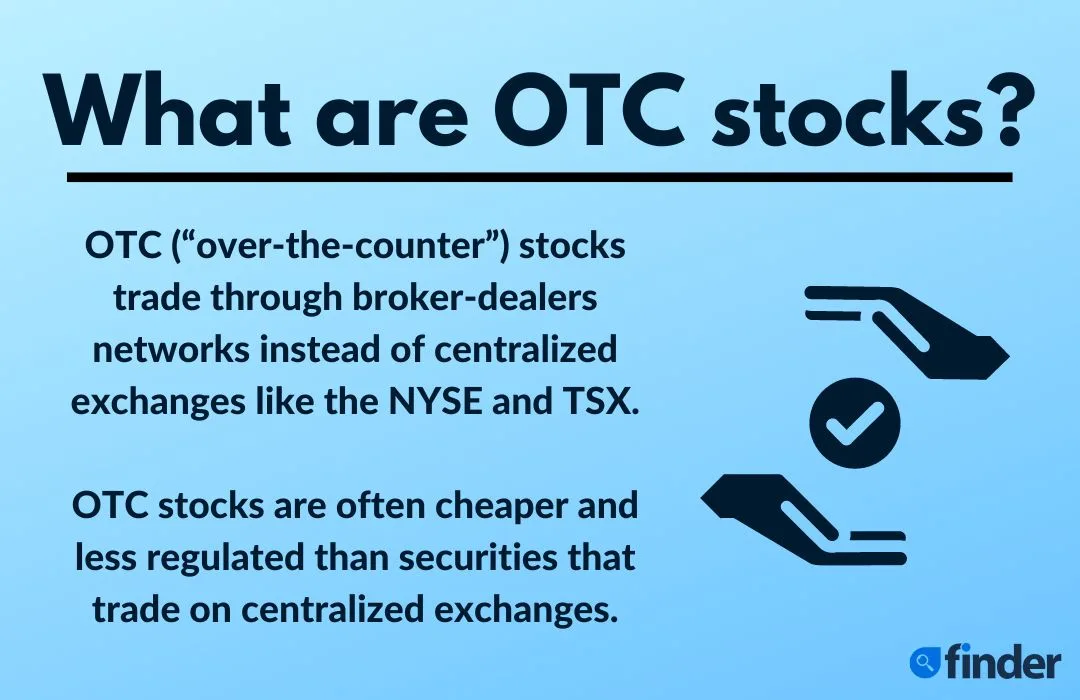OTC Markets, OTC stocks, “pinks sheet” listings — over the counter instruments can go by many names. We walk through the Canadian trading platforms provide access to OTC exchanges, how to buy OTC stocks in Canada and the risks involved with trading them.
What are OTC stocks?
OTC (“over-the-counter”) stocks don’t trade on centralized exchanges like the NYSE and TSX. Instead, these stocks trade through networks run by broker-dealers. These stocks are usually cheaper and less regulated than securities that trade on centralized exchanges.

Why do stocks trade OTC?
Many OTC stocks are companies that are just getting off the ground. They may not meet volume requirements of traditional markets, or the company is looking to save money by listing OTC.
Other stocks are listed in OTC Markets because companies have been delisted from major exchanges, for example:
- A businesses has decided to go private.
- A business has chosen to delist certain classes of its stock, in which case, those stocks could end up being traded over the counter.
- In rare cases, a business has been forced off an exchange for failing to adhere to rules set by stock exchange regulators or the US Securities and Exchange Commission (SEC).
How to buy OTC stocks in Canada
1. Get a broker. Not all brokers let you buy stocks on OTC Markets, so you need to check with your chosen broker. From the ones we’ve reviewed on our site, Questrade, Qtrade and Interactive Brokers let you trade OTC stocks.
2. Fund your account. Make sure you have enough funds to cover your trade.
3. Do your research. You need to make sure you do plenty of research into the stocks you want to invest in.
4. Find the stock on your chosen platform. Just type in its ticker symbol or company name (for example: ADDDF for adidas AG.).
5. Buy your over-the-counter stock.
OTC Trading Platforms
You can trade OTC stocks through the platforms below. Be aware that certain platforms may restrict OTC Markets transactions. For example, CIBC Investor’s Edge only allows OTC Market trades to be executed with a live representative; you can’t initiate a trade yourself through an online account. Additionally, CIBC doesn’t allow OTC stock trading through registered accounts like RRSPs and TFSAs. So, if you want to trade OTC stocks with CIBC Investor’s Edge, you’ll have to open a non-registered investment account.
Finder Score for stock trading platforms
To make comparing even easier we came up with the Finder Score. Trading costs, account fees and features across 10+ stock trading platforms and apps are all weighted and scaled to produce a score out of 10. The higher the score the better the platform - simple.
What is an OTC Market?
OTC stocks are listed in 1 of 3 OTC markets owned and managed by the OTC Markets Group:
| Name of market | Description |
|---|---|
OTCQX (The Best Market) | The qualifications to list on this market are stricter than either of the other markets. Many of stocks are for blue-chip companies in Canada, Europe, Brazil and Russia. Penny stocks cannot trade on this platform. Examples include Heineken N.V. (HINKF), Deutsche Telekom AG (DTEGF) and adidas AG (ADDDF). |
OTCQB (The Venture Market) | This is the mid-tier market on which OTC stocks can trade. Most of the stocks listed on this platform are for young and growing companies in the US and other countries. Examples include Liberty Broadband Corp. (LBRDB), Solaris Resources Inc. (SLSSF) and Freddie Mac (FMCC). |
OTC Pink (The Open Market) | Stocks that don’t qualify for the OTCQX or OTCQB are listed on OTC Pink by default. Companies don’t have to disclose information to be listed, which is why these stocks are considered the most risky. |
The system OTC Markets uses to facilitate trades is called OTC Link, which is regulated by the US SEC. OTC Link is registered as a broker-dealer and an Alternative Trading System and is also a member of the Financial Industry Regulatory Authority (FINRA) in the US.
What are pink sheet stocks?
Pink sheets refer to stocks listed on OTC markets. Formerly known as the National Quotation Bureau (NQB), OTC Markets listed the prices of stocks and bonds on pink and yellow papers. The NQB was renamed Pink Sheets LLC in 2000 and again to OTC Markets Group in 2011.
OTC stock list
There are more than 12,000 stocks on OTC Markets, which you can view and filter using the stock screening tool on the OTC Markets website.
Some companies choose this avenue to avoid filing with the SEC, while others may have been delisted from other exchanges. Others, like Samsung Electronics (OTC:SSNL.F) are massive, billion-dollar-market-cap companies that trade on OTC Markets and foreign exchanges.
Many stocks trade over-the-counter because the company is still to small or infrequently traded to meet the volume thresholds of larger exchanges. For instance, before Walmart became the conglomerate it is today, it traded OTC.
Some companies with stocks listed on OTC Markets include:
- Grayscale Ethereum Trust (ETHE)
- Nestlé S.A. (NSRGY)
- Nissan Motor Co., Ltd. (NSANY)
- Enbridge Inc. (EBBNF)
- Alimentation Couche-Tard Inc. (ANCUF)
- Volkswagen AG (VWAGY)
- Canadian Imperial Bank of Commerce (CCIXF)—CIBC
- Samsung Electronics (SSNL.F)
OTC stocks vs. penny stocks
These terms are sometimes used interchangeably, but there’s a key difference. OTC stocks are stocks that are listed on one of the markets owned by the OTC Markets Group. Penny stocks refers to stocks that are priced particularly low, usually under USD $5.
Some penny stocks trade on well known stock exchanges such as NASDAQ or TSX. OTC stocks may be cheaper but don’t necessarily count as penny stocks.
The risks of trading OTC stocks in Canada
OTC stocks can be more risky than stocks trading on larger exchanges. Some OTC stocks are highly speculative and therefore come with inherent risk, while others may lack the legitimacy needed to trade on a traditional exchange. If you want to take on some more risk and expose yourself to OTC markets, make sure that you research the company thoroughly, and treat lack of information as a red flag.
Bottom line
Over-the-counter stocks can be a great opportunity for investors, but it’s also risky. Companies aren’t held to the same reporting standards set out by stock exchange regulators or SEC as traditionally-listed stocks are. This makes it harder to research and discover which stocks are actually good investments.
Double check that your trading platform lets you trade OTC stocks, and make sure you know the risks before moving forward. To learn more about online stock trading, check out our detailed guide.
Frequently asked questions on OTC markets in Canada
More on investing

What are the best stocks for beginners with little money to invest?
Want to dive into investing but don’t have much to spend? Take a look at these types of stocks.
Read more…
Meme stocks: What they are and examples of popular stocks
Meme stocks can produce large gains in short periods, but the stocks are volatile.
Read more…
How do ETFs work?
Your guide to how ETFs work and whether this type of investment is right for you.
Read more…More guides on Finder
-
Full guide to paper trading accounts for 2025
How to choose the best paper trading platform to help you learn the ins and outs of investing.
-
How will tariffs affect the stock market?
Find out how the Trump tariffs will impact the stock market and explore Canadian stocks that may be resilient amidst tariffs.
-
What are the best stocks for beginners with little money to invest?
Want to dive into investing but don’t have much to spend? Take a look at these types of stocks.
-
Trading promos & investment account bonuses for 2025
Enjoy perks like free trades and cash back when you open a stock trading account with these online broker promotions.
-
TD Easy Trade review
Use this self-directed trading app to learn the basics of investing with a streamlined app and a number of free trades annually.
-
Best renewable energy stocks
These are the best renewable energy stocks to buy now in Canada.
-
10 best trading platforms and apps in Canada for 2025
Whether you’re a new or experienced investor, these are the best stock trading platforms and apps in Canada.
-
TD Direct Investing Review
Make quick and easy trades using this reputable online trading platform from TD.
-
RBC Direct Investing review
Here’s what you need to know about the benefits and shortcomings of this Big Bank investment platform.
-
Questrade review
Questrade is a leader among Canadian discount brokerages, but is it right for you? Compare fees, features and alternatives here.

